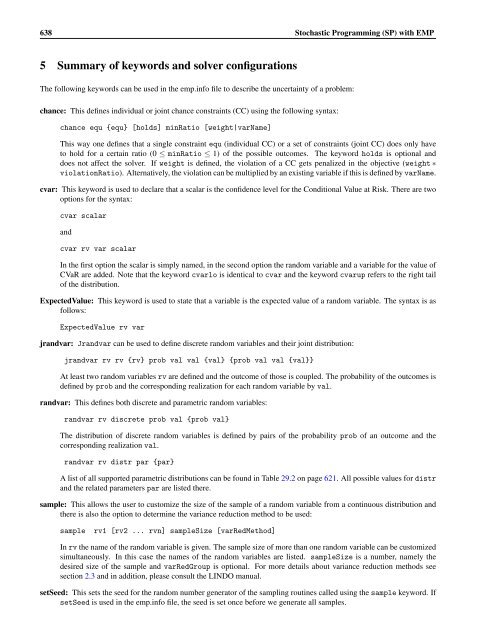Stochastic Programming (SP) with EMP - Gams
Stochastic Programming (SP) with EMP - Gams
Stochastic Programming (SP) with EMP - Gams
You also want an ePaper? Increase the reach of your titles
YUMPU automatically turns print PDFs into web optimized ePapers that Google loves.
638 <strong>Stochastic</strong> <strong>Programming</strong> (<strong>SP</strong>) <strong>with</strong> <strong>EMP</strong><br />
5 Summary of keywords and solver configurations<br />
The following keywords can be used in the emp.info file to describe the uncertainty of a problem:<br />
chance: This defines individual or joint chance constraints (CC) using the following syntax:<br />
chance equ {equ} [holds] minRatio [weight|varName]<br />
This way one defines that a single constraint equ (individual CC) or a set of constraints (joint CC) does only have<br />
to hold for a certain ratio (0 ≤ minRatio ≤ 1) of the possible outcomes. The keyword holds is optional and<br />
does not affect the solver. If weight is defined, the violation of a CC gets penalized in the objective (weight ∗<br />
violationRatio). Alternatively, the violation can be multiplied by an existing variable if this is defined by varName.<br />
cvar: This keyword is used to declare that a scalar is the confidence level for the Conditional Value at Risk. There are two<br />
options for the syntax:<br />
cvar scalar<br />
and<br />
cvar rv var scalar<br />
In the first option the scalar is simply named, in the second option the random variable and a variable for the value of<br />
CVaR are added. Note that the keyword cvarlo is identical to cvar and the keyword cvarup refers to the right tail<br />
of the distribution.<br />
ExpectedValue: This keyword is used to state that a variable is the expected value of a random variable. The syntax is as<br />
follows:<br />
ExpectedValue rv var<br />
jrandvar: Jrandvar can be used to define discrete random variables and their joint distribution:<br />
jrandvar rv rv {rv} prob val val {val} {prob val val {val}}<br />
At least two random variables rv are defined and the outcome of those is coupled. The probability of the outcomes is<br />
defined by prob and the corresponding realization for each random variable by val.<br />
randvar: This defines both discrete and parametric random variables:<br />
randvar rv discrete prob val {prob val}<br />
The distribution of discrete random variables is defined by pairs of the probability prob of an outcome and the<br />
corresponding realization val.<br />
randvar rv distr par {par}<br />
A list of all supported parametric distributions can be found in Table 29.2 on page 621. All possible values for distr<br />
and the related parameters par are listed there.<br />
sample: This allows the user to customize the size of the sample of a random variable from a continuous distribution and<br />
there is also the option to determine the variance reduction method to be used:<br />
sample rv1 [rv2 ... rvn] sampleSize [varRedMethod]<br />
In rv the name of the random variable is given. The sample size of more than one random variable can be customized<br />
simultaneously. In this case the names of the random variables are listed. sampleSize is a number, namely the<br />
desired size of the sample and varRedGroup is optional. For more details about variance reduction methods see<br />
section 2.3 and in addition, please consult the LINDO manual.<br />
setSeed: This sets the seed for the random number generator of the sampling routines called using the sample keyword. If<br />
setSeed is used in the emp.info file, the seed is set once before we generate all samples.

















